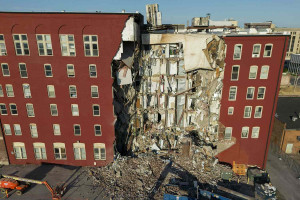Signs to Watch Out for Before a Building Collapse in Nigeria
Posted on 08/03/2024 12:00 PM | by NaijaHouses

By Blessing Clement
What You Need to Know
Building collapses are tragic events that can result in loss of lives and property, leaving devastating impacts on communities. In Nigeria, where issues like poor construction practices, lack of regulatory enforcement, and structural weaknesses are prevalent, the risk of building collapses is heightened. Recognizing the signs of potential structural failure can help prevent such disasters and save lives. In this article, we'll explore key indicators that individuals should watch out for before a building collapse in Nigeria.
1. Structural Cracks:
Visible cracks in the walls, pillars, or beams of a building can indicate underlying structural issues. These cracks may start small but can widen over time, weakening the building's integrity. Horizontal cracks along walls or beams, diagonal cracks at corners, or vertical cracks near doors and windows are all red flags that should not be ignored.
Visible cracks in the walls, pillars, or beams of a building can indicate underlying structural issues. These cracks may start small but can widen over time, weakening the building's integrity. Horizontal cracks along walls or beams, diagonal cracks at corners, or vertical cracks near doors and windows are all red flags that should not be ignored.
2. Sagging or Uneven Floors:
A building with sagging or uneven floors suggests foundation problems or structural instability. Floors that slope or feel soft underfoot may indicate weakening support structures or inadequate foundation design. If you notice floors that appear to be sinking or tilting, it's essential to have a structural assessment conducted promptly.
A building with sagging or uneven floors suggests foundation problems or structural instability. Floors that slope or feel soft underfoot may indicate weakening support structures or inadequate foundation design. If you notice floors that appear to be sinking or tilting, it's essential to have a structural assessment conducted promptly.
3. Excessive Vibrations or Movement:
Buildings should not exhibit excessive vibrations or movement, especially during windy conditions or minor disturbances. Excessive sway or shaking can indicate structural deficiencies, insufficient bracing, or compromised stability. Residents or occupants who experience noticeable vibrations or movement within a building should seek professional inspection and evaluation.
Buildings should not exhibit excessive vibrations or movement, especially during windy conditions or minor disturbances. Excessive sway or shaking can indicate structural deficiencies, insufficient bracing, or compromised stability. Residents or occupants who experience noticeable vibrations or movement within a building should seek professional inspection and evaluation.
Properties for sale in Abuja FCT
For Sale: Experience Luxury Living at Its Finest
For Sale: Standard finished 4 bedroom fully detached duplex
For Sale: STUNNING EXECUTIVE DETACHED DUPLEX
For Sale: Discover Prime Commercial Space at Garnet Mall
For Sale: Experience Luxury Living at Its Finest
4. Water Leakage and Dampness:
Water leakage and dampness can significantly weaken building materials over time, leading to structural decay and instability. Persistent water stains, damp patches on walls or ceilings, or mold growth are signs of water infiltration that should be addressed promptly. These issues not only compromise structural integrity but also pose health risks to occupants.
Water leakage and dampness can significantly weaken building materials over time, leading to structural decay and instability. Persistent water stains, damp patches on walls or ceilings, or mold growth are signs of water infiltration that should be addressed promptly. These issues not only compromise structural integrity but also pose health risks to occupants.
5. Signs of Overloading:
Buildings are designed to support a specific amount of weight based on their structural capacity. Signs of overloading, such as added storeys, unauthorized extensions, or heavy equipment stored on upper floors, can stress the building beyond its limits. Visible signs of stress, such as bending columns or sagging beams, indicate that the building is under excessive load and at risk of collapse.
Buildings are designed to support a specific amount of weight based on their structural capacity. Signs of overloading, such as added storeys, unauthorized extensions, or heavy equipment stored on upper floors, can stress the building beyond its limits. Visible signs of stress, such as bending columns or sagging beams, indicate that the building is under excessive load and at risk of collapse.
6. Poor Construction Practices:
Buildings constructed using substandard materials or poor construction techniques are at a higher risk of collapse. Signs of poor construction practices include inadequate reinforcement, improper concrete mixing, or lack of adherence to building codes and standards. Buildings erected hastily without proper oversight or quality control measures are particularly susceptible to structural failures.
Buildings constructed using substandard materials or poor construction techniques are at a higher risk of collapse. Signs of poor construction practices include inadequate reinforcement, improper concrete mixing, or lack of adherence to building codes and standards. Buildings erected hastily without proper oversight or quality control measures are particularly susceptible to structural failures.
Recognizing the signs of potential building collapse is crucial for ensuring the safety of occupants and surrounding communities in Nigeria. By being vigilant and proactive in identifying structural deficiencies, individuals can take preventive measures to mitigate risks and prevent disasters. Regular inspections, timely maintenance, and adherence to building regulations are essential steps in safeguarding against building collapses and promoting structural safety and resilience.
Quick Links:
- Residential and commercial plots of lands
- 4-bedroom fully detached duplex with a room BQ
- Whiterose Cullinan Garden 4-Bedroom Apartment
- WELL DETAILED BRAND NEW 4 BEDROOM TERRACE DUPLEX
- 4 BEDROOM TERRACE WITH BQ, 3 & 2 APARTMENTS
- 3bedroom furnished and serviced terrace duplex
- Tastefully furnished and serviced 3bedroom apartment
- A Tastefully Finished 10 units Of 4bedroom Terrace Apartment
- 21.29 hectars of land with R of O at Idu Abuja
